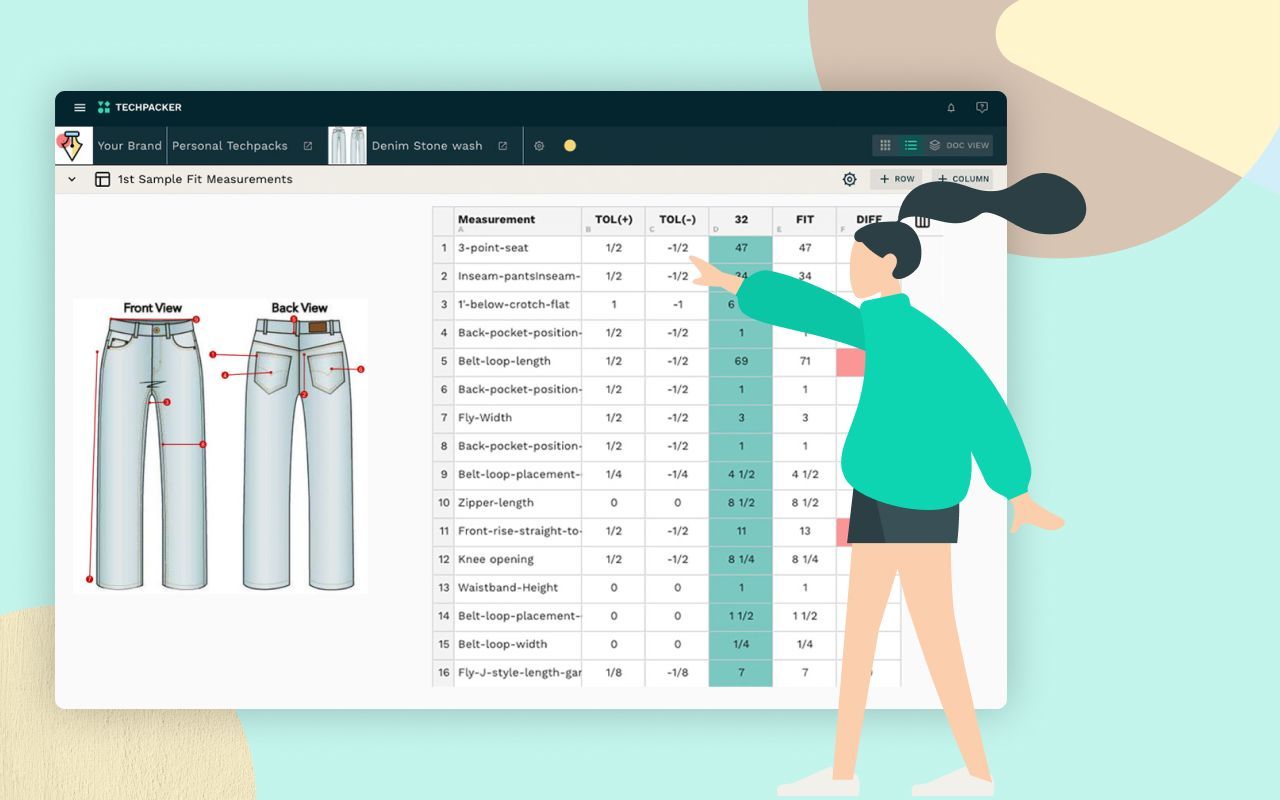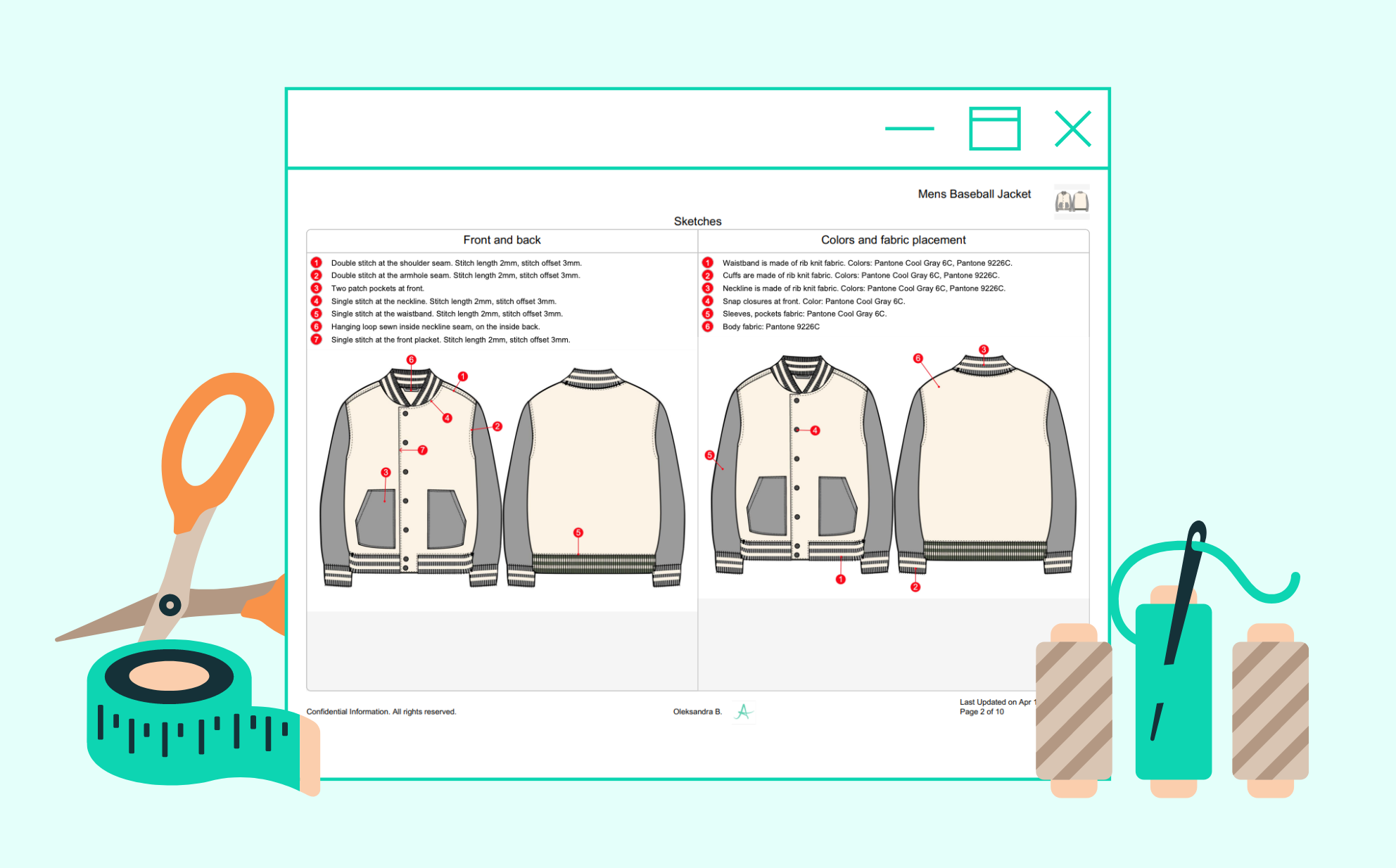Contents
A tech pack is a collection of documents generated by the design team to describe their idea to a manufacturer so that it may be turned into a finished garment. Essentially, it is a communication tool used by designers and manufacturers. A tech pack also serves as a collaborative space in which designers, product developers, buyers, and quality control planners can collaborate.
Technical sketches (or fashion flats), building specifications, measurements, a Bill of Materials, and a price sheet are all common components of a tech pack. In this blog article, we will walk you through the process of creating a tech pack for apparel.
For this tutorial, we will use Techpacker product development software. Let's take a look at the structure Techpacker provides for creating a tech pack:
Techpacker provides a pre-set template for all essential tech pack elements:
- Sketches with construction details;
- Bill of Materials;
- Measurements;
- Costing Sheet;
- One-click PDF generator.
In this post, we will create a jacket tech pack on Techpacker step-by step.
Sketches and construction details
Each tech pack begins with technical sketches (also known as fashion flats). They reflect the concept of how a garment should look when finished. Fashion flats should show every design feature from various angles. We recommend incorporating front and back views, as well as any close-up features when creating a tech pack for clothes. This will assist your factory and pattern maker in visualizing how to create the initial clothing sample to look as near to your desired product as feasible.
Technical sketches are often drawn in black and white using Adobe Illustrator. However, creating flat sketches on Ai requires some graphic design skills. Luckily there are some online vector editors available online that don’t have much of a learning curve. We like Repsketch as it provides a large open-source library of vector product sketches. This way designers do not have to create designs from scratch.
For this tutorial, we will re-purpose this jacket design from Repketch.
We will quickly change some of the design details and colors.
Once we finish the sketches, we will start setting up our tech pack. Follow our guide here on how to set up a tech pack on Techpacker.
We will add the cover image and sizing information. And select the units of measurement.
In the sketch section of the tech pack, we will add a card with front and back views of our garment. Directly on our sketch we will draw call-outs with construction details.
The next step is to add Pantone colors along with the material placement. Add the main fabric information, as well as the lining if applicable. Also, specify types of closures and hardware information.

A Bill of Materials
A Bill of Materials (BOM) is a detailed list of all the components needed to construct a product. BOM assists brands in estimating material costs in order to plan purchases and avoid waste. It also ensures that you never overlook a single button or other minor feature when creating your products.
When creating a piece of clothing, you will need to obtain a shell material, accent material, and lining if required, as well as notions and thread. All of this will be on your BOM table, along with labels, hand tags, and packaging supplies.
We strongly advise you to include supplier information in your Bill of Materials. This will save a significant amount of time when it comes time to order a new batch of materials.
Measurements
The measurement specification sheet (or measurements table) is a detailed description of the measurements of various components in a certain garment. One of the most significant documents used in the production of a garment is the garment measurement sheet. As a result, it is critical to prepare a precise measurement sheet.
A garment measures sheet consists of technical illustrations with callouts and a measurements table. Callouts (sometimes known as annotations) show how measurements are taken.
A clothing measurements table should include every measurement required for a pattern maker to create the pattern for a given garment.
For our garment, we will include the following important measurements:
- Full length. This measurement is taken from the highest point shoulder (HPS) to the hem.
- Shoulder to shoulder. This measurement is taken from one shoulder seam line to another.
- ½ chest. This measurement is taken seam to seam 1” below the armhole.
- ½ hips. This measurement is taken seam to seam at the widest part of the hips. Since we have a waistband on our jacket, we will take this measurement right above it.
- ½ waistband. We will take this measurement from seam to seam.
- Full sleeve length. This measurement is taken from the armhole seam line at the shoulder seam and down to the hem of the sleeve.
- Armhole. This measurement is taken straight from the top of the armhole to the bottom.
- Waistband/cuffs width. Taken from the top of the waistband/cuff to the bottom.
- Neck width. Taken from one HPS to another.
- Neckband with. Taken from the top of the band to the bottom.
- We will also take measurements of the pocket, like its width, length and opening.
We will a detailed sketch of the neckline:
And a detailed sketch of the pockets:
Once we finish adding the annotations to our sketches, we will add the sample size measurements. Please note that all of these are taken when the garment is laid flat.
To learn more about apparel sizing and measuring download our ebook here.
Grading Sheet
On Techpacker, the grading sheet will be a part of your measurements table. Once you enter your sample size measurements you can calculate all the other sizes with the help of Techpacker’s auto-grading tool.
All we have to do is enter our grading rules and the system will automatically calculate the measurements for each size.
In addition to that, we will add tolerances to our measurement table. Tolerance allows a small margin of error, a plus-or-minus measurement that is acceptable and meets the quality standards.
Costing Sheet
A costing sheet is used to determine the cost of a product. It is an excellent budgeting tool. You will know how much it will cost to make one garment and the entire production run once you receive a quote from your factory. In general, the more garments you produce, the lower the cost per garment will be.
The costing sheet for a garment will include:
- Labor cost;
- Materials costs, like main fabric, lining, notions (basically everything from your BOM table);
- Labels and tags;
- Packaging materials.
On Techpacker, you can generate your Costing Sheet based on your Bill of Materials table:
From there, you can add additional information like labor, shipping, etc. This table includes the pre-set formulas so once you enter consumption and cost per unit, you will be able to calculate the total cost of your garment.
Share with the manufacturer
Once you have your tech pack ready, you can generate a PDF doc in one click and share the factory-ready clothing tech pack with your manufacturer.
The sample-making procedure begins after you share the tech pack with your manufacturer and sign the manufacturing agreement with them. The tech pack may be updated several times during this procedure until you are satisfied with the final output. As a result, it's critical to keep each tech pack version on hand and compare them as needed.
Bonus: a free clothing tech pack template
Use our free clothing template as a starting point for your own design or as a reference guide.



